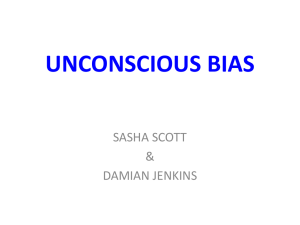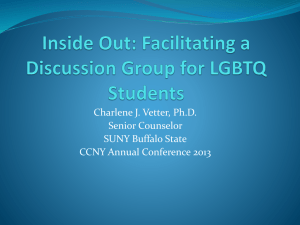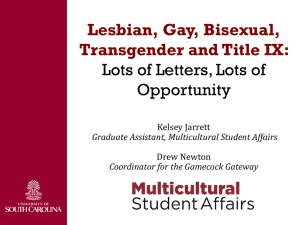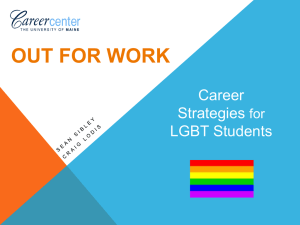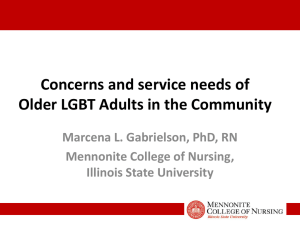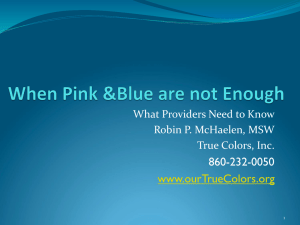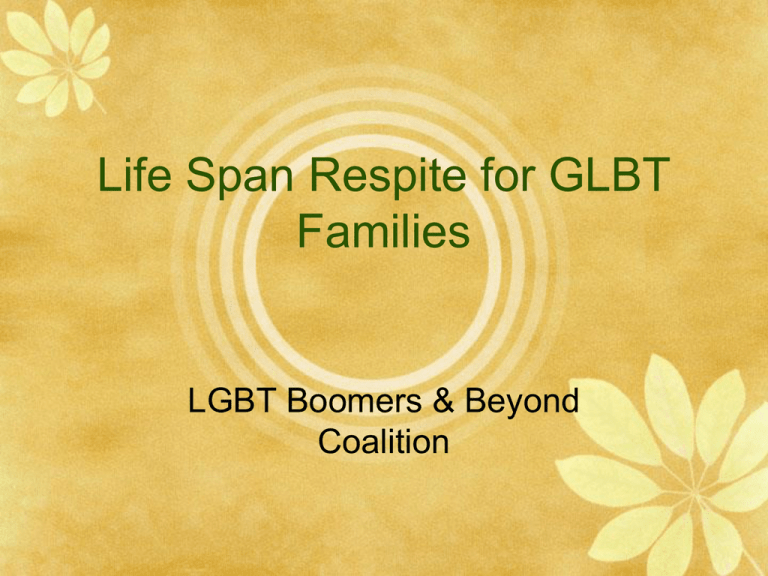
Life Span Respite for GLBT
Families
LGBT Boomers & Beyond
Coalition
Presenters
Adero C E Allison, PhD
Transitioning Adults plus®
Donna Heppermann, MSW
LGBT Boomers & Beyond Coalition
Why do we need to discuss
this community?
How are GLBT any different from
anyone else?
3 Barriers Impede Successful
Aging
Reduced Financial Security
Unequal Treatment under laws & programs
Reduced Health & Health Care
Medical decision-making laws exclude families
of choice, Nursing Homes leave LGBT especially
vulnerable
Reduced Community Support
Stigma, Isolation from LGBT Community,
Discrimination in Housing access
© 2009 Allison, Brown & Collegae, Inc.
LGBT Youth Are:
2 to 6 times more likely to attempt suicide
than heterosexual youth.
30% of all reported teen suicides
50% of all gay and lesbian youth report that
their parents reject them due to their sexual
orientation.
26% of gay and lesbian youth are forced to
leave home (40% of homeless youth)
25% verbally abused by parents, 10% dealt
with threatened or actual violence
28% drop out of high school, 27% have been
physically hurt by another student
(PFLAG Phoenix, 2011)
LGBT Older Adults Are:
Twice as likely to age as a single person
Twice as likely to live alone
Three to four times less likely to have
children to support them
More likely to develop mental health and
substance abuse issues
A life time of fear creates hesitation to seek
services
(National Resource Center on LGBT Aging, 2011)
LGBT General Statistics
12% care for non
relatives
14% care for friends
18% care for partners
36% care for parents
1 in 5 unsure who will
take care of them
40% expect medicare
to pay for care (it
doesn't).
NOT included in
FMLA for partner care
Denied decision
making and visitation
Excluded from end of
life decisions
(National Resource Center on LGBT Aging, 2011)
Health Marginalization
Heterosexual
GLBT
Health insurance
covers family
Supplemental
insurance for spouses
Prescription drug
coverage
Lack of coverage for
family of choice, kicked
out of biological family
Supplemental
insurance denied
Costly prescriptions
not covered
© 2009 Allison, Brown & Collegae, Inc.
Three Main Issues Faced by
LGBT Aging
Aging Parents & Older Relatives
Aging Alone or With a Partner
Aging With Disabilities or In Good Health
Narrative - Safe Housing
Personal Experience Rev. Adero C E Allison, PhD
We visited a transgender woman from our church who had been
admitted to a facility for care. Upon visiting her it was noted
that she was in a room with and treated as a man. She was not
helped from her bed to her powerchair for weeks at a time,
keeping her isolated in her room. A used urinal was left on her
bedstand (the one meals are served on). It was there on two
different visits even though we complained to the director of
the facility. She was unshaven with her hair not combed and
matter in eyes on most visits. It was striking that her nonambulatory roommate appeared clean and cared for.
(Allison, 2011)
Narrative - Assisted Living
Personal Experience Rev. Adero C E Allison, PhD
A Care Manager took two
women to visit an assisted living
community to determine whether
this would be a good alternative
to their condo. The Sales Person
informed them that no two
women could live together in
their community. The rules
prohibit cohabitation by any
other than married individuals. It
was not clear whether couples
were asked to produce their
marriage certificates with their
applications.
(Allison, 2010)
Implications: LGBT do not
share the benefits of shared
income that are mostly
covered by marriage.
Myths and Facts
True or False
Gay people don't live nearly as
long as heterosexuals.
Older adults—those age 50 and
older—are not at risk for HIV or
AIDS.
(Southern Poverty Law Center, 2011)
(LGBT Aging Center, 2011)
FALSE - This falsehood can be traced directly
to the discredited research of Paul Cameron
and his Family Research Institute, specifically
a 1994 paper he co-wrote entitled, "The
Lifespan of Homosexuals.”
FALSE - The rates of HIV/AIDS among older
adults 50 and over have increased more than
61% from 2001 to 2007. Research shows that
those age 50 and older now comprise 27% of
the overall population of people living with
HIV/AIDS, and by 2015 will become the
majority of all people living with HIV /AIDS.
In addition, the latest national data show that
adults 50 and older account for.
Myths and Facts
True or False
Older adults are not
sexually active.
Older adults are less likely
to be tested for HIV/AIDS
than other age groups.
(LGBT Aging Center, 2011)
FALSE - Research shows
heterosexual and LGBT older adults
are sexually active well into their
mid-80s, with a 2007 national study
showing 53% of adults age 65-74
and 26% of adults age 75-85 as being
active with one or more partners.
TRUE - Older adults are less likely
to be tested because they are not
perceived to be at risk, including
being sexually active and/or
intravenous drug users.[In addition,
doctors are less likely to ask older
patients about sexual activity.
How many GLBT are served
by your organization?
10 - 12% of the adult population
means probably the same
percentage of your clients
(whether you know them or not)
What’s Missing?
LGBT Community Connections:
A Process That Links LGBT
aging and the Service Provider
Community
An Example of Straight Allies
and the LGBT Community
Working Together
LGBT B & B Coalition
History
Started by talking with people known
from the LGBT community
Began a caregiver support group
Put together a group of representatives
from the LGBT community and open &
affirming community agencies
Presented community seminars on legal
issues
What’s Missing?
Safe and Affirming Services:
Cultural Competency Training
and Policies that Directly
Address this Community
Offer Safe and Affirming Care
Options
© 2009 Allison, Brown & Collegae, Inc.
Be Prepared to Answer These
Questions (and more)
Are there any same gender couples or lesbian/gay
individuals in your community/organization?
How are they treated by staff? by other residents?
Do you have policies that might impact care of a
LGBT persons?
Do admission forms acknowledge partnership
relationships?
Some Questions to Ask
Yourself as a Provider
Does my staff honor the level of
‘outness’ or ‘not outness’ of individuals
How do we distinguish between
Gender Identity vs. Physical Attributes
when providing care?
What’s my level of knowledge of issues
that affect the LGBT community?
Organizations that May Help
PFLAG (nine chapters in Arizona)
National Gay & Lesbian Task Force
Services & Advocacy for Gay &
Lesbian Elders
LGBT Boomers & Beyond Coalition
One Voice Community Center
GayArizona.com for resources near
you
What’s Missing?
Advocacy for Laws That Protect
Economic Resources:
Personal and organizational
action to encourage equity in
legal protection.
Invisible People
Research at the federal
and state levels is almost
non-existent
No mandate to provide
culturally competent
services to LGBT people
Federal “safety net”
programs (Soc. Sec.,
Medicaid etc.) define family
in ways that dis-empower
and exclude LGBT
families, partners and
spouses
© 2009 Allison, Brown & Collegae, Inc.
Legal Contrasts
Traditional Marriage
Same Sex Life Partner
Soc. Sec. Survivor
benefits
Soc. Sec. Spouse eligible
for ½ of spouse’s benefit
Medicaid protects assets
and homes when spouse
enters nursing home or
LTC
Tax laws protect 401Ks &
pensions for spouses
No Survivor benefit
Unmarried partners not
eligible
No matching benefit for
life long partners – may
lose their home when
partner needs care
Tax laws discriminate
against surviving partners
© 2009 Allison, Brown & Collegae, Inc.
Housing
. . . and for these older adults who want
a place to retire, the answer might be
one of about 25 retirement communities
in the U.S.-- catering specifically to gays
and lesbians -- that are available now or
planned for the near future.
© 2009 Allison, Brown & Collegae, Inc.
“Some older people put off health
care because they don’t want to have
frank discussions about their
orientation with their doctors.” Jay
Smith Executive Director the Ventura
County Rainbow Alliance gay advocacy
group
Transgender Health
Access to health care and health
insurance is even less prevalent among
transgender individuals.
Transgender youth and people of color
may be particularly at risk of economic
and social marginalization, including
poverty and homelessness.
Now is the time to address the
services every aging adult
should have access to.
© 2009 Allison, Brown & Collegae, Inc.
The Landscape is Changing
More than One in 10 Same-Sex Couples
Include a Partner over 65,
More than One in Four Include a Partner
over 55
By 2020 the number of gays and lesbians
over 50 in the US will have gone up to nearly
six million
The number of GLBT Americans over 65 will
more than double in the next 25 years, from
an estimated 3 million to 7 million.
Next Steps
Introduce LGBT Cultural Competency
Training Into Our Organizations
Establish Safe Environment Practices for
Employees and Residents
Spread the Word!
2nd Annual Statewide LGBT Boomers and
Beyond Conference
April 27 & 28, 2012
Visit our Website:
http://lgbtboomersandbeyond.wordpress.com/
Transitioning Adults plus®
Our passion is to provide services that embody trust,
integrity and a person-centered approach helping
families through transitions caused by aging and/or
disability.
LGBT Boomers and Beyond
A coalition enhancing quality of life through
resources, education and advocacy, so that Arizona
LGBT Boomers and Beyond are aware, empowered
and connected.
Resources
•
Outing Age: Public Policy Issues Affecting Gay
Lesbian Bisexual and Transgender Elders by Sean
Cahill, Ken South and Jane Spade
http://www.thetaskforce.org/reports_and_research/outing_age
_2010
•
Find the Dollars You Deserve A Roadmap to Federal
Funding for Aging Services: Navigating the Federal
Government for Lesbian, Gay, Bisexual and
Transgender Organizations
http://www.thetaskforce.org/downloads/resources_and.../find_
the_dollars.pdf
•
Caring for caregivers The issues—and
interventions—are different for racial and ethnicminority caregivers. By Rebecca A. Clay February
2009, Vol 40, No. 2
http://www.apa.org/monitor/2009/02/caregivers.aspx
Resources
•
Gay and Lesbian Retirement Communities: Gays
and lesbians over 50 find friendship, community
and mutual support, By Sharon O'Brien
http://seniorliving.about.com/od/housingoptions/a/gay_housin
g.htm
•
Population Resources Center: Providing the
Demographic Dimension of Public Policy
http://www.prcdc.org/300million/The_Aging_of_America/
Resources
The Cost Of Marriage Inequality To Gay, Lesbian And
Bisexual Seniors: A Human Rights Campaign
Foundation Report January 29, 2004
http://www.hrc.org/documents/cost_of_marriage.pdf
Senior-care providers face more gay, lesbian, bisexual
and transgender clients, report indicates from:
Pioneer Press | December 22, 2010
http://www.aarp.org/relationships/caregiving/news-122010/senior_care_providers_face_more_gay_lesbian_bisexual
_and_transgender.html
Resources
10 Anti-Gay Myths Debunked By Evelyn Schlatter and
Robert Steinback, Southern Poverty Law Center
http://www.splcenter.org/get-informed/intelligencereport/browse-all-issues/2010/winter/10-myths#
LGBT Aging Center
http://lgbtagingcenter.org/resources/resource.cfm?r=322
Unmarried Partners Make Up 6% of U.S. Households
Advocate.com Editors
http://www.advocate.com/News/Daily_News/2011/05/04/Unmarried_P
artners_Make_Up_Six_Percent_of_US_Households/
For More Information
LGBT Boomers & Beyond Coalition
www.lgbtBoomersAndBeyond.org
Transitioning Adults plus®
. . . life transition guidance
1-888-795-6838
www.TAplus.com
© 2009 Allison, Brown & Collegae, Inc.


